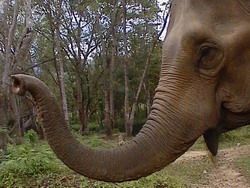Elephants are everywhere in India. Real ones parade down the streets during festivals and even on ordinary days. Bronze statues of elephants in shop windows everywhere. Highly-colored statues. Necklaces. Plastic knick knacks. An elephant is simply good luck. If you see an elephant on your way while going somewhere, your purpose of going will be fruitful. You invoke or touch a picture of the half-elephant god Ganesh, the remover of obstacles, before beginning an endeavor. The elephant is revered. An India without elephants is simply unimaginable.
Like many tourists, I took an elephant ride up to the Amber Palace in Jaipur.

A mahout starts as a boy in the family profession when he is assigned an elephant early in its life. They mahout and elephant remain bonded to each other throughout their lives.

The elephants at the Amber Fort live nearby, in Hathi Gaon, which is a walled enclosure. The owners bathe them at the end of the day. Elephants eat up to 330 lbs of plant matter per day

Indian elephant ears are the shape of the Indian continent (African elephant ears are shaped like Africa– and they are bigger elephants.) The elephants flap their ears to stay cool.


It was a truly stable and powerful feeling being on top of an elephant. It smelled differently than being on a horse.

———————————————————————————————————————————————
There are still wild elephants in India, and they are threatened by habitat loss and human-elephant conflict. Concern for the threat to the elephant led to the formation in 1992 of the government backed “Project Elephant”, a program intended to preserve habitat and establish elephant corridors, allowing for the traditional migration patterns of established wild elephant herds.

Leave a comment